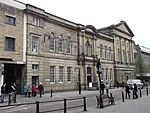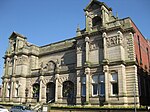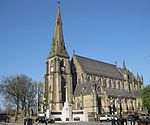Gigg Lane
This article needs additional citations for verification. (May 2021) |
 | |
 Gigg Lane Location of Gigg Lane | |
| Full name | Gigg Lane Stadium |
|---|---|
| Location | Gigg Lane Bury, Greater Manchester |
| Owner | Bury F.C. (1885–) |
| Operator | Bury F.C. (1885–2019) |
| Capacity | 12,500 (all-seated) (Currently 11,840 due to segregation in the Les Hart Stand) |
| Record attendance | 35,000 |
| Field size | 112 x 73 yards (102 x 67 metres) |
| Construction | |
| Built | 1885 |
| Opened | 1885 |
| Tenants | |
| Swinton RLFC (1992–2002) F.C. United of Manchester (2005–2014) | |
Gigg Lane is an all-seater football stadium in Bury, Greater Manchester. One of the world's oldest professional football stadiums, it was built for Bury FC in 1885 and has been their home ever since. In recent years, the ground was officially known for sponsorship reasons as the Energy Check Stadium and it became the Planet-U Energy Stadium following a deal signed by the club with Leeds-based Planet-U Energy on 19 February 2019.
The ground has been unused since August 2019, when Bury FC was expelled from the English Football League. In November 2020, the club was placed in administration and Gigg Lane was put up for sale in May 2021 by the administrator.
History[]
The first match to be played at Gigg Lane was a friendly between Bury and Wigan on 12 September 1885, which Bury won 4–3. The first league game was a 4–2 victory over Manchester City on 8 September 1894 in the 1894–95 Football League Second Division.[1] The stadium has had permanent floodlights since 1953, although the first floodlit match to be played there took place in 1889, before the Football League had authorised the use of floodlights in competitive matches.[citation needed]
The capacity of the ground was once 35,000 and this was achieved when the ground's record crowd attended Bury's FA Cup third round tie against Bolton Wanderers on 9 January 1960. The game ended 1–1 and Bury lost the replay after extra time 4–2.[1] In 1986, Gigg Lane saw its lowest ever crowd of just 461 for a Freight Rover Trophy game against Tranmere Rovers. There has never been a league crowd below 1,000 although the closest to that mark came in 1984 with a crowd of 1,096 against Northampton Town. The highest all-seater attendance at Gigg Lane was recorded when Bury played Manchester City on 12 September 1997, with an attendance of 11,216.[citation needed]
The ground was renamed the JD Stadium in November 2013 after Bury announced a new sponsorship deal with JD Sports.[2] The deal was ended in July 2015.[3] In 2016, it was announced that the club was looking to build a new 15,000–20,000 capacity stadium in the borough of Bury.[4] No progress was made and there was a change of club ownership in December 2018.[5]
On 19 February 2019, it was announced that the ground would officially be renamed the Planet-U Energy Stadium after Bury concluded a five-year sponsorship deal with the Leeds-based renewable energy supplier, Planet-U Energy. It was intended that the stadium would be powered by 100 per cent renewable energy.[6][7][8][9]
In August 2019, however, the club was expelled from the Football League because it could no longer guarantee its financial viability. It has continued to exist, though it has no team, and it still owns Gigg Lane which remains unused as a football ground.[10] On 27 November 2020, the club was placed in administration.[11] In May 2021, Gigg Lane was put up for sale by the administrator.[12]
Structure and facilities[]
This section needs additional citations for verification. (May 2021) |
After the Taylor Report forced all Football League clubs to switch to all-seater stadiums, the club began converting all four sides of the ground in 1993, with the Cemetery End being the final terraced section to be demolished in 1999. The East Stand on the rebuilt Cemetery End has a capacity of 2,500. The South Stand is the largest and it was renamed the "Les Hart Stand" in the summer of 2010; it contains a pattern of blue and white seats that spell out "SHAKERS"
The Manchester Road End (capacity 2,100) was home to the club's electronic scoreboard (obtained from Leicester City's Filbert Street ground after it closed in 2002) until 2011. A new scoreboard was placed in the south-east corner of the ground a few months later.[13] In September 2015 a screen was installed in the right-hand side of the Les Hart Stand. On matchdays the club show advertisements, match highlights and the scoreline.
In November 2015, Bury announced that the Main Stand was to be renamed the Neville Neville Stand in honour of the late English cricketer and friend of the club, Neville Neville.[14] Towards the end of the 2015–16 season, a fence was constructed between the Cemetery End and the Les Hart Stand in an attempt to stop the rise of hooliganism at the ground. This further separated home and away supporters but it reduced the stadium's capacity with the consequent loss of 660 seats. The stadium's official capacity in May 2019, when Bury last played there, was 12,500 (reduced to 11,840 due to the segregation).[citation needed]
Other users[]

FC United of Manchester shared the ground from the 2005–06 season until 2014. They moved into their own ground for the 2015–16 season. FC United set a club record attendance of 6,731 when they played Brighton and Hove Albion in the FA Cup on 8 December 2010.[citation needed]
Other clubs have moved their "home" games to the stadium, including Preston North End for a League Cup tie in 1994. Non-league Rossendale United and Radcliffe Borough moved home FA Cup ties to Gigg Lane against Bolton Wanderers (in 1971) and York City respectively.[1] Manchester United and Bolton Wanderers have hosted reserve-team matches at the ground.[citation needed]
In 1996, the stadium was used as the filming location for the TV film based on the Hillsborough disaster of 1989, where 96 Liverpool fans died as a result of a crush on the stadium's terraces.[citation needed] Hillsborough was seen as an unsuitable location for the film, partly to avoid causing further distress to survivors and bereaved families, and partly because the appearance of Gigg Lane was more akin to the 1989 Hillsborough than the actual stadium was seven years after the tragedy due to redevelopment.[citation needed]
The stadium has been used for many sports other than football. Swinton Lions regularly played rugby league at Gigg Lane between 1992 and 2002. Other sports played there have included cricket, baseball and lacrosse.[citation needed]
References[]
- ^ Jump up to: a b c Gordon Sorfleet (18 June 2012). "Gigg Lane, the home of Bury Football Club". Bury FC. Retrieved 4 November 2012.
- ^ Paul Handler. "Gigg Lane renamed JD Stadium after Bury FC strike commercial deal". Manchester Evening News. Retrieved 12 November 2013.
- ^ Ben Collins (7 July 2015). "Bury FC to change name of JD Stadium after bagging new sponsorship deal". Manchester Evening News. Retrieved 5 May 2017.
- ^ "Bury planning new 15–20,000 capacity stadium by 2018–19 season, says chairman Stewart Day". Sky Sports News. 5 October 2016.
- ^ "Steve Dale becomes new Bury owner". BBC Sport. 11 December 2018. Retrieved 22 February 2019.
- ^ Brad Marshall (19 February 2019). "Renewable energy firm announce sponsorship deal with Bury FC". Bury Times. Retrieved 19 February 2019.
- ^ "Bury FC in stadium naming rights deal". Sport Industry Group. 19 February 2019. Retrieved 1 March 2019.
- ^ "Gigg Lane, home of Bury FC, to be renamed the Planet-U Energy Stadium". Brief Report. 19 February 2019. Retrieved 1 March 2019.
- ^ "Bury's Gigg Lane renamed in renewable energy drive". TheStadiumBusiness. 19 February 2019. Retrieved 1 March 2019.
- ^ George, Thomas (30 August 2020). ""We have done something special already in getting here" – A year on from Bury FC's expulsion from the Football League, hope is returning to the town". Manchester Evening News. Manchester: MEN Media. Retrieved 9 February 2021.
- ^ Lord, Adam (27 November 2020). "Bury FC placed in administration as part of 'rescue' plan". Bury Times. Retrieved 3 December 2020.
- ^ George, Thomas (11 May 2021). "Bury FC's iconic Gigg Lane stadium put up for sale by administrators". Manchester Evening News. Retrieved 13 May 2021.
- ^ "New Scoreboard installed". Buryfc.co.uk. 17 May 2011. Archived from the original on 12 November 2013. Retrieved 12 November 2013.
- ^ "The Neville Neville Stand". buryfc.co.uk. Bury Football Club. Retrieved 16 January 2019.
External links[]
| Wikimedia Commons has media related to Gigg Lane. |
Coordinates: 53°34′49.82″N 2°17′41.36″W / 53.5805056°N 2.2948222°W
- F.C. United of Manchester
- Bury F.C.
- Football venues in England
- Sports venues in Greater Manchester
- Buildings and structures in Bury, Greater Manchester
- Defunct cricket grounds in England
- Cricket grounds in Greater Manchester
- Sports venues completed in 1885
- Sport in Bury, Greater Manchester
- English Football League venues




